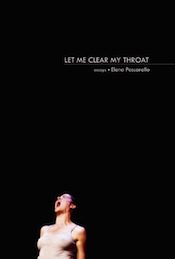
Confession: I spend a lot of time hanging out in a dive piano bar in Oakland, and I can just imagine Elena Passarello, author of a quality new collection of essays about the human voice, walking in. A former actress and winner of the 2011 Stella Screaming Contest (a quirky credit she leans on a little too hard in her book), she’d set her Scotch on the piano and quietly size the other singers up. She’d meekly wait her turn, but as soon as that mike got in her hands, she’d suck in enough breath to power a category five hurricane. Then she’d sing from the gut with the same brute voice you will hear on the page when she analyzes “ripped to shit phonemes” or describes Robert Plant’s flat F in the fifth octave as “a double backflip of sex and longing that nails its ten-point landing, twice.”
If Elena Passarello walked into the Alley, I’d think, I sure hope that annoyingly loud girl will do her thing, get her rocks off, and leave.
But Passarello on the page is another matter, an informative, insightful, inviting guide to the bizarreness of our vocal being. I picked up her new collection, Let Me Clear My Throat because I wanted to learn about the complex physiognomy of the voice—this full-body instrument of larynx, epiglottis, cords, sinuses, diaphragm, lungs, and more. And I found Passarello’s essays a wonderfully literary way to gain this education, while absorbing the life tales of a few great crooners, actors, and sportscasters besides.
Her essays on singers strike me as especially smartly structured. She builds her consideration of Frank Sinatra’s genius, titled “Teach Me Tonight,” upon the sections of a guide to popular singing published in the forties by Sinatra’s vocal coach: Preface, General Instructions, and Mouth Positions UH, AYE, EE, and OO. Did you know that Sinatra created his style by modifying Bing Crosby’s “plucky AH” into an UH sound? That, as Passarello writes, “The sonic thrill of any yodel is a vocal byproduct that Sinatra learned to mask early on: the rough ‘break’ in the voice as it pops from chest to head” on an EE? That, after a strep diagnosis, Sinatra “spent a week of vocal rest in an oxygen chamber, miming hand signals to his valet” and that he “suffered a ‘submucosal hemorrhage’ onstage at the Copa”?
Perhaps Passarello is strongest when connecting the blood-and-sinew science of singing to the emotional self-sacrifice of artistry. In “JUDY! JUDY! JUDY!,” she fits the drama of Judy Garland’s life inside a song-by-song analysis of Garland’s famous Carnegie Hall concert. In “Hey Big Spender,” Passarello considers the castrati, and though this essay is more structurally unwieldy, it concludes with a moving meditation that “there is a certain kind of artistry that, at its most heroic, blends skill and expression into a performance of ultimate expense [. . .] It is sexy to think that another person has given his life (or his gonads) to make a perfect note, or that he is killing himself in front of us just to get music out of his mouth.”
The collection is organized in three parts: “Screaming Memes,” “Tips on Popular Singing,” and “The Thrown.” I was far less drawn to the screaming essays, which sometimes make enormous presumptions about the reader’s interest. Passarello’s essay about the Stella Screaming Contest—held in New Orleans, where contestants try to best Marlon Brando’s bully cry—begins “Here is all I can tell you about what it sounds when I open my mouth and scream.” Hmm. The piece is brilliant in flashes, but strains to make the stuff of a viral YouTube video into a work of digressive profundity. Ditto Passarello’s exegesis of presidential candidate Howard Dean’s famously campaign-imploding scream, “Communication Breakdown.”
A few other essays here would be more potent at half the length—for instance, Passarello’s appreciation of the Pittsburgh football commentator Myron Cope. A few others (notably “And Your Bird Can Sing,” a mopey lyricizing about crows in winter) feel like grad school exercises. (Passarello studied at the University of Iowa with John D’Agata.)
Connecting the essays are short interviews Passarello conducted with vocalists of various odd persuasions—Elvis impersonator, failed “American Idol” auditioner, telephone psychic. I was surprised that I began to look forward to these well-juxtaposed interludes as the book progressed, though the collection’s final essay, a satirical questionnaire completed by the dummy half of a real-life ventriloquist act, fell flat.
But overwhelmingly, Passarello’s artfully written book speaks confidently—and frequently, it sings. You’ll want to listen.





